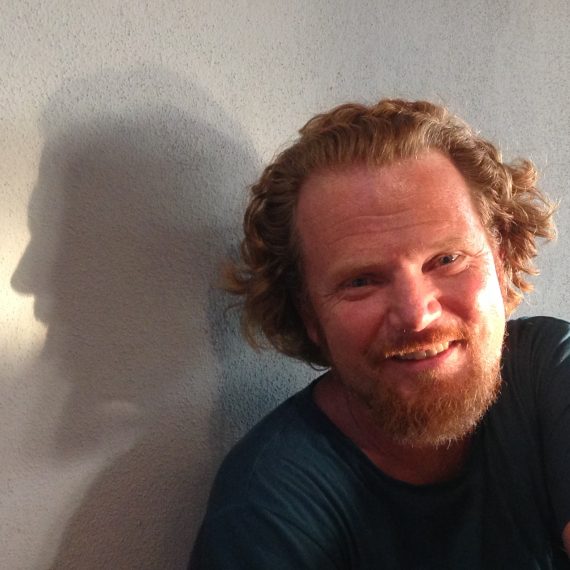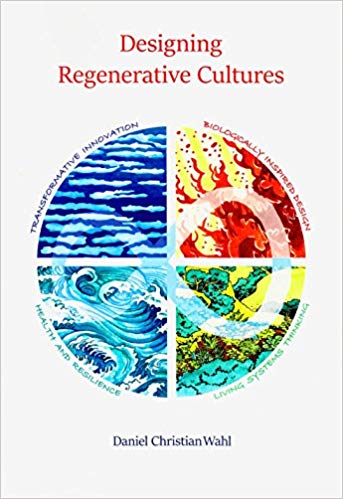
Daniel Wahl, ON SURVIVAL
Daniel Wahl is a leading educator, international consultant and design expert specialising in biologically-inspired whole systems design, transformative innovation and regenerative bioregional development. He is a biologist (University of Edinburgh and University of California), and holds an MSc in Holistic Science from Schumacher College and a PhD in Design, from the University of Dundee, 2006.
Daniel currently works with diverse collaborators weaving glo-cal networks in support of regenerative development and ecosystems restoration. His first book, Designing Regenerative Cultures, was published in 2016 and is a must-have handbook for anyone interested in how to redesign the human impact on Earth from being degenerative and exploitative, to being regenerative and healing. Daniel lives with his family in Mallorca, Spain.
Daniel tweets, and he is on Facebook and he has an excellent blog on Medium.
Here is a transcript of his words from our Podcast.
Daniel Wahl, Nordic By Nature ON SURVIVAL
My name is Daniel Wahl. I used to be a marine biologist, got disheartened with reductionist science and lack of including other ways of knowing into the way we do science, and ended up doing a Masters in holistic science at Schumacher college.
At that point, I realized the power of Design in putting this new holistic world view of Gaia theory and Goethian and holistic science interaction, and have been on this path of a sense of exploring how we can redesign the human presence and impact on earth within our lifetime, so we can actually have a future as a species, because we are currently facing the possibility of short term human extinction, if we don’t fundamentally change our ways.
Life is a planetary process. And we are part of that planetary process.
I work a lot now within with the term regenerative design and regenerative development. Sustainable being something that is really ways of doing things that don’t add any more damage to the system. And restorative and regenerative, going beyond that, and actually trying to undo the damage that we’ve done over so many decades and centuries of very unsustainable practices. So, it’s very much about finding solutions that come out of ‘place,’ that attuned to the story that the place itself wants to tell, and the people who have lived with it for generations. But it also is central that it’s about enabling their capacity – of the people who actually live in that place to respond to change as in an inevitable.
My belief is that design has a huge part in making that possible.
Well, the process of the United Nations responding to climate change has been painfully slow.
With the Paris breakthrough, there’s been some form of commitment of staying under two degrees average warming globally. But more recently the IPCC has revised that, and has said that it’s necessary to actually stay below one point five degrees. The reality is we’re not on track at all.
We’re on track to six seven eight degrees warming which basically would mean the unravelling of ecosystems around the globe and the end of civilization as we know it.
The most recent report actually it was November 2008 in gave the world 12 years to fundamentally respond to this crisis. But I think that again the IPCC has a tendency to be conservative, so they don’t get criticized. And 12 years is too long of a window of opportunity to give ourselves.
I think Antonio Guterres the Secretary General of the U.N. in September last year was probably more on the mark by saying that if we don’t respond within the next two or three years, in the way that is unprecedented in terms of international collaboration, then we might have triggered runaway climate change to a point that even if we decide afterwards to do something about it, it would be too late.
We don’t even know half or more than half of the species yet that exist. Particularly the species in the soil microbes. We’re just at the beginning of cataloguing them all. And really that’s where soil fertility starts, and with it the foundations for higher lifeforms.
It’s really understanding that every single species does matter and has a role to play in creating this collaborative symbiotic system that is basically life as a planetary process. And we’re part of it, and we’re completely dependent on it.
——————————————————-
I strongly believe in the power of design.
I think ultimately, it’s about design as human intentionality expressed through interactions and relationships. It covers product design but it also covers other more complex issues like monetary systems, transport systems our whole economic system and even the way we do research in the different academic disciplines.
There’s a design decision at the beginning of each discipline. So, basically any act human intention has a design element in it.
In that sense, the most powerful design intervention is the meta design intervention of changing people’s world views and value systems, and the stories we tell about each other and in our relationship to nature. When you shift that then our perceived and our real needs shift. And with that our intention shifts in everything down stream changes.
I think design is powerful and designers very often oversell it, and most design schools still haven’t actually woken up to how critical design and deep ecological design thinking could be to the survival of our species.
——————————————————-
There are a lot of companies out there who are supplying things we don’t really need or they’re supplying them in a way that is based on programmed obsolescence and turnover of products.
And I don’t think that that kind of business practice has a future.
I think we need to create much more durable products that much more easily repairable at a local level.
But we also need to create products that are to some extent, the components are more recyclable. But really if you go deeper, you realize that most of the materials we make things out of, we’re going to run out of sooner or later.
So, all that thinking around Circular Economy and two loops in the Circular Economy diagram with a cradle to cradle diagram, the industrial metabolism and the biological metabolism, they’re really just concepts.
Ultimately, we’re going to have to shrink the industrial metabolism because most of the materials in that cycle we won’t be able to recycle forever.
So, one of the big oversells around that is this concept of upcycling. It doesn’t actually work to up cycle things indefinitely, unless you have a free source of energy and there is no such thing.
We’re really needing to fundamentally shift our material culture towards more biomaterials that are regenerative grown, in the region, for the region, and based on the resources that that particular ecosystem has to offer.
It has to be done in such a way that it doesn’t destroy the rest of the ecosystem. So, the contrary, it has to be done in a way that it regenerates the ecosystem.
Basically, these companies are beholden to their shareholders. They operate within a system that is fundamentally exploitative and degenerative. Then that system is our current economic system.
The way that we’ve designed money and the way money is created and the way that we have differential interests on deposit and loans and therefore create an economic playing field that is based on a zero-sum thinking, so basically on winners and losers. And while we have a system like that, and we have that necessity that a national economy needs to grow at a minimum at 3 percent per annum otherwise it collapses,
There are a lot of top-level sustainability minded CEOs that really do care, and yet they are stuck in a system where to some extent, most of what they do is moving deck chairs on the Titanic.
Ultimately, they really need to consider that maybe the assumption that these companies, just because they’ve been around for 100 years, have to be around for another hundred years, might be an erroneous assumption.
Maybe some of these companies actually have to program for their own… or design for their own death in ways that they can then re-emerge in like a phoenix from the ashes, as knowledge networks that help more regional production and regional consumption [00:09:39] With the innovation and development that they’ve been very good at.
That’s at the CEO level.
But for a lot of people who are working in these companies, who are beginning to see that their children are not going to school on Fridays because they’re claiming they’re right for a Liveable Future. Or they see London being disrupted by the Extinction Rebellion and more and more people getting more and more verbal about the fact that it’s five past 12.
We don’t even have a guarantee that we are still going to be able to make it if we do things fundamentally different now.
Most people today are still somewhat stuck in beginning to realize how profound the changes are that we are now called to do individually, as communities, as nations, and as one human family. And at the same time making sure our kids are in school, and that we can pay their bills, so the food’s on the table.
But we are facing transformative change in a way that these incremental innovations, and these incremental changes, just aren’t going to make it in time. So, hold onto your hat.
We have to relearn how to collaborate. Moving from competitive advantage to collaborative advantage. And realizing that we’re all in this together. Living Spaceship Earth is in danger of collapsing on us.
We’re living in a dream-nightmare, that that tells the story that was somehow separate from nature that culture and nature are not one.
—————————————–
I’m increasingly thinking that working by regionally is the scale at which we can make the biggest difference.
Bio- regionalism has been around since the late 1960s, and this whole concept of re habitation re inhabiting our bio regions, and reconnecting to the biological cycles, the ecological cycles of those regions,
Increasingly also the conversation about what would sustainable cities look like– Understand that it is a reconnection of the city back to its region. So, I could definitely see that there could be models developed in Sweden. It’s the same with a lot of regions that people have strong allegiance to their particular region.
And so, I think that’s a great starting point because one of the core things about regenerative development and creating regenerative cultures is that they are born out of the uniqueness, the bio cultural uniqueness of place.
They are sensitive to both the ecological and biological uniqueness of the ecosystems they inhabit, but they also are sensitive to the historical cultural dimension, of how people have lived in relationship with nature, and with the elements and with climate, and with the patterns of that particular place, and I think it makes …makes a lot of sense to rekindle those regional identities, but to not do so in a sort of parochial “Let’s go back and pull up the draw bridges, and create lifeboats in a turbulent world” But as understanding that that is the scale of action for a globally collaborative effort to heal the planet, that we have raped and pillaged, basically, and in doing so possibly also heal ourselves, heal our relationship to each other and heal the relationship between humanity and nature.
—————————————–
I know that in Costa Rica there’s a movement to create a bio-regional regenerative development case study in one part of the country. And actually the whole country is looking at adopting regenerative development as.. as their main development strategy.
Things are shifting.
Luckily, I also see that there’s a confluence of movements in all walks of life like people trying to transform business from within.
In recent years the Capital Institute started initiatives to work with people in regions to create these “regen” economy hubs at the bio regional scale. This movement is growing and the different players unnecessarily fully aware of themselves.
I’m also thinking of the Planetary Health Alliance with network of universities and research institutions around the world doing the research and looking into the connections between planetary health ecosystems, Health Population, Health and individual health. We need to really understand the intrinsic value of our life and planetary health to the whole community of life.
And then there’s organizations like Common land in the Netherlands who’ve developed functional strategies to do large scale ecosystems restoration, working with local farmers, and local landowners, in specific areas around the world, and transforming entire regions that are between 500,000 and a million hectares.
The momentum is building. I think the next two years are critical. I’m still hopeful. We are actually going to see this transformative change to become a global emergency response.
——————————————-
It’s only now that we’re slowly beginning to link up the people who have pioneered works in sustainable cities and sustainable architecture and in more bio-materials construction methodologies and so forth with new and pioneering in buy materials and product design, with all the wonderful work that is in kind of Earth Care and earth healing eco therapy from permaculture to agroforestry to analogue forestry and all these other techniques that have been around for a while and have been improved over years and years of experimenting.
We also have lots of case studies to point out that we can if we choose to have a positive impact on the environment that we inhabit. There are plenty of places around the world where large scale regenerative agricultural projects have shown impressive ways; the before and after that is possible in 15, 20 years.
I am thinking of the Lös plateau example that John Low was now founded the ecosystems respiration camp Foundation reported on in the early 2000s. In China, an area of hundreds of square kilometers was being transformed from arid eroding semi desert, to lush terraces that are bio productive with the springs coming back and the tree cover being permanent again, and basically increasing the carbon content in the soil, drawing down carbon from the atmosphere, improving the bio productivity of the area, improving the hydrology of the area, improving the amount of food that it generated and so on.
These things are possible, and there are examples all over the world.
The way that life creates conditions conducive to life is by continuously experimenting with novelty, and so things keep changing. Our planet sits within larger systems as well, that also affect how the conditions on our planet change.
——————————————-
There is no destination sustainability. There is no destination regenerative culture. It is a continuous community-based process of learning of how to adapt and how to respond creatively to change. To do so in ways that we enable people to discover their own essence, their unique contribution to making the system more vibrant and more vital and more valuable. But in all levels of value. not just in economics to economic terms.
We all have to walk that path. That is what life is all about. To be adaptive, resilient and regenerative — respond to change.
END

